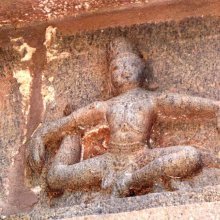Garudapaksha, Garuḍapakṣa, Garuda-paksha: 8 definitions
Introduction:
Garudapaksha means something in Buddhism, Pali, Hinduism, Sanskrit. If you want to know the exact meaning, history, etymology or English translation of this term then check out the descriptions on this page. Add your comment or reference to a book if you want to contribute to this summary article.
The Sanskrit term Garuḍapakṣa can be transliterated into English as Garudapaksa or Garudapaksha, using the IAST transliteration scheme (?).
Images (photo gallery)
In Hinduism
Natyashastra (theatrics and dramaturgy)
Source: Wisdom Library: Nāṭya-śāstraGaruḍapakṣa (गरुडपक्ष) refers to a gesture (āṅgika) made with ‘dance hands’ (nṛttahasta), according to the Nāṭyaśāstra chapter 8. The hands (hasta) form a part of the human body which represents one of the six major limbs (aṅga) used in dramatic performance. With these limbs are made the various gestures (āṅgika), which form a part of the histrionic representation (abhinaya).
Source: archive.org: The mirror of gesture (abhinaya-darpana)One of the saṃyutta-hastāni (Twenty-six combined Hands).—Garuḍa-pakṣa (Garuda wing): Ardha-candra hands held at the sides of the hips, extended upwards. Patron deity Sanandana. Usage: waist string, superiority.
Source: Shodhganga: Elements of Art and Architecture in the Trtiyakhanda of the Visnudharmottarapurana (natya)Garuḍapakṣa (गरुडपक्ष) refers to one of the thirty Nṛttahastas or “dance hand gestures” (in Indian Dramas), according to the Viṣṇudharmottarapurāṇa, an ancient Sanskrit text which (being encyclopedic in nature) deals with a variety of cultural topics such as arts, architecture, music, grammar and astronomy.—The hasta-mudrās (lit. “hand-gestures”) are very essential to denote some particular action or state in dancing and these mudrās are formed with the help of hands and fingers. In the Viṣṇudharmottarapurāṇa, thirty kinds of nṛttahastas (“dance-hand gestures”) are mentioned. e.g., garuḍapakṣa. The practice of these nṛttahastas is strictly prohibited in sickness of body, in old age, in fear, drunk and anxiety.

Natyashastra (नाट्यशास्त्र, nāṭyaśāstra) refers to both the ancient Indian tradition (shastra) of performing arts, (natya—theatrics, drama, dance, music), as well as the name of a Sanskrit work dealing with these subjects. It also teaches the rules for composing Dramatic plays (nataka), construction and performance of Theater, and Poetic works (kavya).
In Buddhism
Mahayana (major branch of Buddhism)
Source: De Gruyter: A Buddhist Ritual Manual on AgricultureGaruḍapakṣa (गरुडपक्ष) refers to the “wings of Garuḍa”, according to the Vajratuṇḍasamayakalparāja, an ancient Buddhist ritual manual on agriculture from the 5th-century (or earlier), containing various instructions for the Sangha to provide agriculture-related services to laypeople including rain-making, weather control and crop protection.—Accordingly, [as the Bhagavān teaches the offering manual of the root-heart] “[...] Having taken a sword, enchanted it 108 times, and painted a Garuḍa on it with saffron, it should be waved. As much as one waves the sword, that much the wings of Garuḍa (garuḍapakṣa) fall on the [Nāgas’] body. All Nāgas are frightened. They flee to the ten directions. They are unable to hurl winds and thunderbolts again. [...]”

Mahayana (महायान, mahāyāna) is a major branch of Buddhism focusing on the path of a Bodhisattva (spiritual aspirants/ enlightened beings). Extant literature is vast and primarely composed in the Sanskrit language. There are many sūtras of which some of the earliest are the various Prajñāpāramitā sūtras.
Languages of India and abroad
Sanskrit dictionary
Source: Cologne Digital Sanskrit Dictionaries: Monier-Williams Sanskrit-English DictionaryGaruḍapakṣa (गरुडपक्ष):—[=garuḍa-pakṣa] [from garuḍa] m. a particular position of the hands.
[Sanskrit to German]
Sanskrit, also spelled संस्कृतम् (saṃskṛtam), is an ancient language of India commonly seen as the grandmother of the Indo-European language family (even English!). Closely allied with Prakrit and Pali, Sanskrit is more exhaustive in both grammar and terms and has the most extensive collection of literature in the world, greatly surpassing its sister-languages Greek and Latin.
Kannada-English dictionary
Source: Alar: Kannada-English corpusGaruḍapakṣa (ಗರುಡಪಕ್ಷ):—[noun] (dance.) one of the hand gestures.
Kannada is a Dravidian language (as opposed to the Indo-European language family) mainly spoken in the southwestern region of India.
See also (Relevant definitions)
Partial matches: Paksha, Garuda.
Starts with: Garudapakshahasta.
Full-text: Nrittahasta, Garudapakshahasta, Samyutta-hastani.
Relevant text
Search found 4 books and stories containing Garudapaksha, Garuḍapakṣa, Garuda-paksha, Garuda-paksa, Garuḍa-pakṣa, Garudapaksa; (plurals include: Garudapakshas, Garuḍapakṣas, pakshas, paksas, pakṣas, Garudapaksas). You can also click to the full overview containing English textual excerpts. Below are direct links for the most relevant articles:
Vishnudharmottara Purana (Art and Architecture) (by Bhagyashree Sarma)
2.2. Hand Postures (c): Nṛtta-hasta < [Chapter 3 - Drama and Dance]
Abhinaya-darpana (English) (by Ananda Coomaraswamy)
Gati in Theory and Practice (by Dr. Sujatha Mohan)
Gati in aerial sphere < [Chapter 3 - Application of gati in Dṛśya-kāvyas]
Natyashastra (English) (by Bharata-muni)
